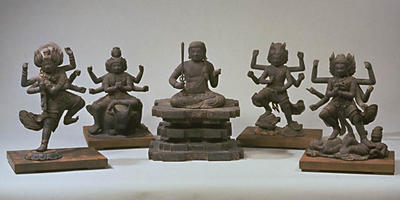:::::::::::::::::::::::::::::::::::::::::::::::::::::::::::::::::::::::::::::::::::::::::::::::::::::::::::::::::::::::::::
Aoi 青不動 blue / green Fudo
. Goshiki Fudo 五色不動明王 in Five Colors .
- Introduction -
Sometimes AO is blue, like the blue mountains we see over there,
sometimes it is green, like in ao-ringo, green apples (the unripe fruit).
. aoi 青い blue and green .
- Introduction -
:::::::::::::::::::::::::::::::::::::::::::::::::::::::::::::::::::::::::::::::::::::::::::::::::::::::::::::::::::::::::::
Me-ao 目青不動 blue (green) eyes of Fudo

Kyoogakuin 教学院 Kyogaku-In
(世田谷区太子堂4丁目)
もとは港区麻布谷町(現:六本木)の勧行寺(または正善寺)にあったが1882 (明治15年)青山南町にあった教学院に移転。
教学院は1910(明治43年)世田谷区太子堂に移転。


- source : tencoo.fc2web.com/jinja

:::::::::::::::::::::::::::::::::::::::::::::::::::::::::::::::::::::::::::::::::::::::::::::::::::::::::::::::::::::::::::
Aoi Fudo 青不動 blue (green) Fudo

source : facebook
.......................................................................
Hanyain, Hannya-In 華香山 般若院 Hanya-In
Kyushu Fudo Pilgrimage, Nr. 02
福岡県福岡市南区大池1丁目3-15, Fukuoka
1 Chome-3-15 Oike, Minami Ward, Fukuoka

http://ojisanjake.blogspot.jp - Jake Davies
.......................................................................
Kenzanji 剣山寺 Kenzan-Ji
Kyushu Fudo Pilgrimage, Nr. 49
The main hall of the temple is a big surprise. It's a Portakabin....., quite a large one for sure, but still its one of those temporary buildings that are dropped in to building sites.

Behind the portakabin are a couple of altars and a small man-made cave containing a Fudo Myo statue painted bright blue.

The rocks behind are painted with flames and its quite a quirky thing.
- source : Jake Davies
鹿児島県日置市日吉町日置1239-6
1239-6 Hiyoshicho Hioki, Hioki, Kagoshima
Visitors say the main statue of Fudo in the temple is sort of smiling, niko-niko ニコニコ and telling them to :
"Don't hurry, don't rush, take it slowly, you are just right the way you are"
「あわてるな、急ぐな、あなたはあなたのままでよい」
- source : www.kyushyu88.com
. 九州88ヶ所108霊場 Kyushu Pilgrims - Fudo temples .
:::::::::::::::::::::::::::::::::::::::::::::::::::::::::::::::::::::::::::::::::::::::::::::::::::::
. Taikooji 太光寺 Taiko-Ji . - Hiroshima
seated statue
:::::::::::::::::::::::::::::::::::::::::::::::::::::::::::::::::::::::::::::::::::::::::::::::::::::
- MORE - 目青不動 -
- MORE - 青不動 -
:::::::::::::::::::::::::::::::::::::::::::::::::::::::::::::::::::::::::::::::::::::::::::::::::::::::::::::::::::::::::::
. Green Fudo Myo-O 不動明王 .
Most statues of green color are made from bronze (seidoo 青銅).
:::::::::::::::::::::::::::::::::::::::::::::::::::::::::::::::::::::::::::::::::::::::::::::::::::::::::::::::::::::::::::

. - Join Fudo Myo-O on facebook - Fudō Myō-ō .
:::::::::::::::::::::::::::::::::::::::::::::::::::::::::::::::::::::::::::::::::::::::::::::::::::::::::::::::::::::::::::
. Goshiki Fudo 五色不動明王 in Five Colors .
- Introduction -
. Pilgrimages to Fudo Temples 不動明王巡礼
Fudo Myo-O Junrei - Fudo Pilgrims .
[ . BACK to WORLDKIGO . TOP . ]
[ . BACK to DARUMA MUSEUM TOP . ]
:::::::::::::::::::::::::::::::::::::::::::::::::::::::::::::::::::::::::::::::::::::::::::::::::::::::::::::::::::::::::::












































